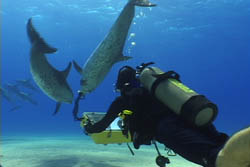
By Hardy Jones, author of forthcoming book The Voice of the Dolphins,
Executive Director BlueVoice.org
Now that Paul Watson and his Sea Shepherds have drive the Japanese whaling fleet from the Southern Ocean to end their whaling season early, the question arises as to what's next for Japanese whaling. Tokyo confirms the whaling fleet has been called home, ending the 2010 - 11 season, but leaves open possibilities of returning to the Antarctic next year.
Of course if Japanese whalers return to the Antarctic seas they will face Watson and his fleet - probably stronger and more imaginative than ever. In addition international law regulating shipping in the Antarctic will mandate, as of August 2011, that machinery using heavy oil be replaced by devices running on light oil. That is not massive expensive but would require a refit of the factory ship Nisshin Maru in times when the bogus scientific whaling operation is not coming close to paying its way through sale of whale meat.
In addition the factory ship is old and dottering. She has had two fires in recent years that, had they gotten out of control, could have unleashed devastating pollution in the sensitive Antarctic ecosystem. Is building another factory ship an option? I don't think so. I was on the Nisshin Maru some years ago when she tied up in Japan. It was like being on an aircraft carrier. There could be no economic incentive for building another of these Goliaths when sales of whale meat are falling and huge unmarketable stockpiles of whale meat are stuffing freezers in Japan.
Japan's bureaucracy is by no means united in support of whaling. The Foreign Ministry and Ministry of Trade and Industry have spoken internally against whaling as something that damages Japan's image and commerce. But Japan's Fisheries Agency is so powerful it has been able to override opposition to whaling. This is the same agency that supports the slaughter of thousands of dolphins in Japan.
The fisheries agency has tried to expand the take of dolphins. Taiji, the town made infamous by the film "The Cove", built an expensive new abattoir in hopes of expanding output of dolphin meat. But interest in dolphin is declining as more people become aware of the levels of mercury and other contaminants in the meat.
Japan also hunts whales in the Northwest Pacific. Likely the Nisshin Maru will depart for these whaling grounds in May. In recent years they've taken Bryde's, sei, sperm and minke whales. This hunt takes place in Japanese territorial waters and would not be accessible to Sea Shepherd action. But there are reasons to question the wisdom of hunting these populations of whales. Sperm whales taken in past years were declared unit for human consumption due to high levels of pollutants in the meat.
An emerging element in the calculus over whaling is the presence of disease antibodies in many marine mammals around the world. Kazue Ohishi of the University of Tokyo and his colleagues discovered pathological and seriological evidence of Brucella infection in baleen whales taken in the Northwestern Pacific. Brucellosis is a disease with proven zoonotic potential. It can spread from one species to another. Workers exposed to contact with animals or meat -- such as slaughterhouse workers, farmers, and veterinarians -- are at high risk of this serious disease. The possibility of transmission of Brucellosis from raw whale or dolphin meat to humans is a very real possibility.
The increase in diseases such as Brucellosis among immune suppressed marine mammals is another sign of the deterioration of the ocean environment. It is a brutal absurdity that whales be hunted in such a circumstance.

